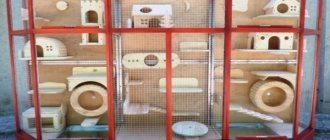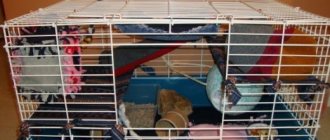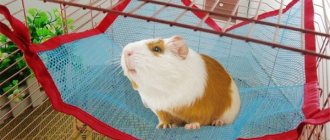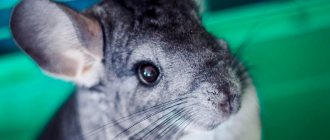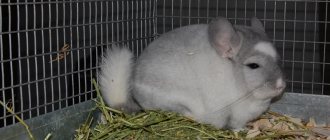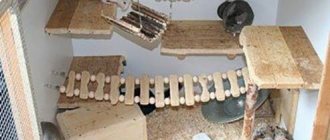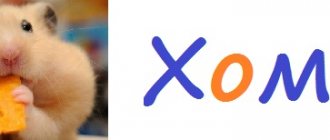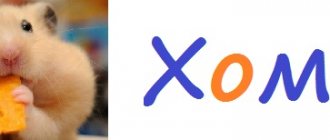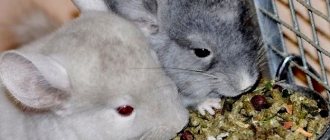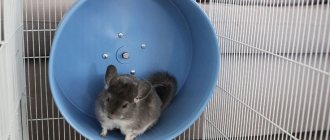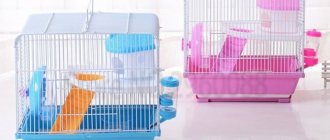What are the hay and feeders for?
The list of accessories includes more than a dozen, among which haymakers and feeders come to the fore. Despite the fact that the rodent eats very little, special dishes for food must be installed.
Considering that most food spoils quickly, it is important to select a bowl of the right size so that the animal has time to eat a portion without leaving the leftovers to rot.
Sennitsa is a type of feeder with a narrow specialization. It contains hay that chinchillas need every day to normalize digestion processes. The separation of hay as a separate accessory is due to the fact that the animal is capable of defecating throughout the cage, touching valuable dry grass.
Sennitsa in the form of a hanging ball is dangerous for chinchillas
Useful properties of meat
It has long been known that not only chinchilla fur is of great value.
Some farmers prefer to raise individuals only for the purpose of obtaining meat products. These animals have tender, low-calorie meat, which is in demand among connoisseurs, as well as people with certain diseases. Chinchilla meat is consumed by patients with sclerosis of various forms, as well as to relieve the symptoms of tuberculosis. This dietary product is in high demand among people with cancer, because rodent meat has healing properties, and the components included in its composition prevent the active development of tumors.
Only healthy adults are used for meat
Sennitsa for chinchilla: varieties
A high-quality chinchilla hay feeder must meet the following criteria:
- safety for the animal;
- holding an armful of hay inside;
- the ability for the chinchilla to freely get the required amount of grass;
- no chance of urine getting on valuable food.
Manufacturers of pet supplies produce several types of hay feeders: internal and external, metal and plastic.
Experts definitely do not recommend buying:
- plastic products - they are quickly chewed by animals;
- hanging wire balls - the animal can stick its head inside and get stuck.
Opinions are divided regarding the location inside or outside. Some experts prefer the first option due to the preservation of cleanliness.
The following factors speak in favor of external ones:
- saving additional space in the cage;
- complete safety for the animal;
- dried grass does not crumble.
Tips for use
The installation height of the soft shelf is a very important factor. It should be comfortable for the pig to climb into it. And in the event of a fall, the animal should not be injured. Therefore, it is recommended to hang the device at a height of 6 cm to 15 cm from the bottom of the cage.
The dimensions of the product should allow the pet to rest freely on it.
The fabric of the product must be durable. Choose fleece or denim.
The hammock will last longer if there are no threads sticking out of the seams. The pig can chew on these threads, and the product can unravel.
Feeder for chinchillas: what are they?
The choice of feeders in the pet store is large, so before purchasing you should familiarize yourself with the parameters that the ideal solution meets:
- material. Plastic is excluded, it will be eaten along with the food in a short time. Experts advise choosing metal bowls, although you can consider glass or ceramic;
- form. It is important to purchase a stable container that can be placed on the floor. The chinchilla will remove the hanging structure from the bars and scatter pieces of food throughout the cage;
- fastening. The feeder must be firmly attached to the cage - rodents love to play with containers, turning them over.
A ceramic feeder can be original.
An automatic feeder will cost a little more, but solves many problems:
- simply integrated into the cell;
- doses the amount of feed;
- a rodent cannot use it instead of a toilet;
- the ingress of debris is virtually eliminated;
- in this case, cleaning the cage is simplified.
Peppermint treat
Ingredients:
- 1 medium overripe banana.
- 2 chicken eggs.
- 3 tbsp. spoons of honey.
- 3 tbsp. tablespoons of liquid coconut oil (can be replaced with sunflower oil in the same amount).
- 1/2 teaspoon mint flavoring.
- 1/2 teaspoon baking powder.
- A quarter cup of carob (roasted carob powder). A small amount of cocoa can be substituted, but this is not recommended for animals. Therefore, try to find an original product.
- Oat flour.
Cooking procedure.
1. Mash the banana in a bowl.
2. Beat eggs into the resulting mass, add honey, baking powder, cinnamon and coconut (sunflower) oil.
3. Add oatmeal to the mixture to form a firm but slightly moist dough.
4. Divide the resulting volume into 2 equal parts.
5. Pour 1/4 cup of carob powder into one half, and add the same amount of flour to the second half. A hard lump should form that does not stick to your hands.
6. Roll out 2 rectangles, 9-10 mm thick.
7. Place the layers of dough on top of each other and roll along the long side. Wrap the resulting sausage in plastic wrap and put it in the refrigerator overnight.
8. Preheat the oven to 180 degrees.
9. Cover a baking sheet with parchment paper.
10. Remove the film and cut into 3-3.5 cm rounds.
11. Place on a baking sheet. During cooking, portions of dough will not increase in volume, so you can place them close to each other.
12. Bake for 10-15 minutes.
If you want to please your pet with a crunchier treat, cut the rolls into thin slices (about 1 cm), and after cooking, additionally dry them in a warm oven or even in a non-stick frying pan.
The finished product is stored for a long time in a dry place. So, by baking peppermint rolls once, you can treat your four-legged pupil with them for a long time.
Bon appetit to your dog!
I like it I don't like it
How to make a hay box for a chinchilla with your own hands
For experienced and skilled owners, a do-it-yourself chinchilla hay rack is preferable. To do this, you need:
- Saw and sand the boards for the side walls, bottom, and back wall. The latter can be made more elegant by cutting out a semicircle.
- Make a slot in the side walls to attach the grille.
- Connect all the walls.
- Secure the grille.
- Sand again, rounding all corners.
Finally, you need to attach the hay box under the shelf in such a way that it is easy to replenish the hay, and a rodent cannot climb into the device.
Drinking bowl
A drinking bowl for a chinchilla must meet certain requirements: be closed, have enough volume, and be securely fastened. The most successful option are automatic drinkers or nipple-type drinkers. They allow you to keep water clean and fresh for several days.
Making a drinking bowl at home
You can make a drinking bowl for a rodent with your own hands from a bottle of saline solution. In addition to the bottle, you need to have a pipette tube and a small piece of wire. Manufacturing begins by removing the rubberized cap from the bottle and making a hole in it at a slight angle. The diameter of the hole should be slightly smaller than the diameter of the pipette - this way it will fit more tightly into it. Insert the pipette. The bottle is wrapped with wire and attached to the outside of the cell so that the tip of the pipette is inside the cell. It is better to fix the drinker at an acute angle - this way water will not drip to the bottom of the cage.
DIY chinchilla feeder: instructions
Making your own feeders for chinchillas will not take much time. Thoroughly washed and treated cans, heavy ceramic bowls, and glass ashtrays are suitable as bowls.
The owner only needs to securely fasten the container so that the rodent cannot turn over or move the feeder from its place. After that, it’s enough to pour in the food and enjoy the process of feeding your pet.
For interesting ideas on how to make your own house for a chinchilla and what can be used as a bathing suit from scrap materials, read the article “Homemade and purchased houses for chinchillas” and “Purchased and homemade bathing suits for chinchillas.”
How to train a guinea pig to a hammock
Accustoming to innovation should be done gradually. You should not place a new device in the cage of a pig that has only recently appeared in the house. To do this, the animal must live in the new place for at least two months.
After installing the hammock, the pet may get used to the update for several days, and then begin to be interested in it. The behavior of the pet after the appearance of the innovation needs to be observed. The pet can immediately start jumping into the new bed. If the hammock is located too high, then you need to identify this in time and move it lower.
If the animal does not show interest in the innovation, then you can lure it with a treat. But you shouldn’t get carried away with the food, as the new place can turn into a dining room.
If your pet gets nervous when new objects appear in the cage, then it is better not to make him nervous. You can try a more modest hammock or skip using one altogether.
A hanging lounger should not be frequently moved from place to place. This can only be done after the pet has completely gotten used to it.
Sennitsa for chinchilla
Buying a chinchilla as a pet also involves purchasing various accessories for the animal. In order for him to be comfortable 24 hours a day, even when the owners are away from home or sleeping, the enclosure should have a convenient drinking bowl and bowl, as well as a hay box for the chinchilla. When it comes to the hay barn, novice owners always ask a lot of questions: what is the point of it, is it possible to arrange it yourself if the pet store doesn’t have anything suitable in terms of type and price.
What is sennitsa
Hay is the main food for chinchillas. And sennitsa is a type of feeder. Eating dried herbs normalizes the functioning of the chinchillas’ digestive system and provides the animal with vitamins and microelements.
You can’t just scatter food in the cage, since the animals defecate wherever they want. And then they won’t eat food with feces. The chinchilla's hay box should be placed on a raised platform in a separate feeder - a hay box.
- safety for chinchilla;
- holding an armful of dried grass inside;
- the ability for the animal to easily get and eat a portion of hay;
- guarantee that feces do not get into the food.
Grass collection
If it is winter and there is no way to find fresh plants, ready-dried hay for pets can be purchased at pet stores or ordered online. It contains guinea pig-safe plants and is fully prepared for pet consumption.
Well, if summer is in full swing, you can collect the grass yourself, while adhering to the following rules.
- The plants that you will harvest should be located away from large cities, highways and highways.
- You should not collect weed near industrial enterprises, or in areas where livestock graze.
- Only healthy-looking plants with a bright green color should be selected. Stems and leaves should not be affected by parasites or diseases.
- Grass that has already dried out is not suitable for harvesting.
- It is advisable that the harvest include alfalfa and timothy. These herbs are rich in beneficial microelements and have a positive effect on the digestive system of rodents.
Plants that can harm guinea pigs:
After collecting, the grass should be laid out to dry in a dry room. Under it you should lay a cloth or a sheet of white Whatman paper. You can also line the drying area with several sheets of plain white paper. It is not advisable to use newspapers for backing. Ink comes off very easily from printed pages and can stick to blades of grass . Harvested hay should not be exposed to direct sunlight.
Periodically, the grass should be stirred and turned over a little so that the stems dry better and more evenly.
Drying continues until all the stems become dull and brittle. After this, the hay must be transferred to a fabric bag. This will help prevent possible mold formation and growth.
Varieties of sennitsa
The chinchilla canopy can be made in two versions:
- with external fastening to the cage;
- with internal fastening.
Both options have advantages and disadvantages, convenience and operational problems.
Safer for the animal is an external hay. It is not traumatic, does not take up space in the cage, and the hay does not crumble due to the activity of the animal.
And the best option for an internal canopy is made of stainless steel. Chinchilla lovers are very popular with chinchillas in the form of a ball made of wire. This decorates the enclosure. But the disadvantage of these models is that the animal can get its paws or nose stuck between the rods while reaching for the grass. And then, to help him free himself, you will have to make a lot of effort so as not to injure the pet.
It is not recommended to purchase plastic kennels - a chinchilla can chew it off in one day.
How to make a hay box for a chinchilla with your own hands
You can assemble a feeder from materials available at home, which can be found in every household. No DIY skills are needed - just a couple of hours and patience.
Required tools and material:
- thin boards or sheets of plywood;
- metal grid;
- dowels (preferably with a cross-section of 6 mm);
- drill or screwdriver;
- hammer;
- sandpaper (or a drill with a special attachment).
- The board is sawn to the intended dimensions - you will need 4 boards: for the floor, side and back wall. The workpieces must be sanded.
- The mesh is cut to the size of the feeder.
- Slots are made in the blanks for the side walls to secure the mesh to the front and ceiling.
- All parts are connected to each other using dowels.
- The corners of the feeder are sanded.
Options for canopies made from household items
A do-it-yourself chinchilla canopy can also be made using available materials. For example, a stand for forks and spoons with large cells in the walls is suitable. It is better to take galvanized steel so that the chinchilla cannot chew it. In addition, such a hay will be quite heavy. The animal will not be able to move it from its place, and it is easy to attach it to the walls of the mesh using the holes.
Another option, if the enclosure is spacious enough, is to place a metal vase for cookies with slots as a hay box - such vases are sold in the dishware department.
Source
Instructions for choosing and creating your own feeder and kennel for a chinchilla
To provide the chinchilla with stable conditions, a feeder, drinking bowl and hay box are placed in the home.
For drinking bowls and feeders, the material of manufacture (glass, plastic, metal or ceramics) and its weight are important: this way the animal will not be able to turn objects over. It is allowed to use simple dishes if the pet store does not have suitable containers. The normal option for a drinking bowl is an automatic reservoir with a stick, which is attached to the cage: the pet licks the stick and gets water. Filling an automatic drinker with liquid is easier than a regular one.
This article will tell you what sennitsa is and what it is eaten with.
Hay
Before talking about senniks, you should find out what they are needed for. The answer is obvious: hay barns are needed to store hay. Any experienced pig breeder knows about the importance of this product and its benefits for guinea pigs. For those who are just starting their journey in this area, it will be useful to know why a pig needs hay, where to get it and how to choose it.
Why does a pig need hay?
Hay is the most important product in a guinea pig's diet and the main source of fiber. The health of your pet, the condition of its teeth and normal digestion directly depend on hay. It should always be freely available to the animal and kept in stock by the owner.
Where can I get hay?
Hay for guinea pigs can be purchased at a pet store, asked from livestock breeders (at a stable or barn), ordered online, or prepared yourself.
It is necessary to collect grass in places far from highways, industrial zones and livestock walking.
After collection, the hay must be thoroughly dried in a well-ventilated area, constantly turning over. It is better to store the product in linen bags.
What should the hay be like?
- fresh,
- completely dried, without mold,
- free of dust and small particles,
- with long stems,
- composition – forbs (timothy, alfalfa, etc.),
- Green colour,
- smell - fragrant.
What are the hay and feeders for?
The list of accessories necessary for the animal is about a dozen, the first among them being a drinking bowl and a hay box. Although the rodent eats little, special dishes must be placed in the cage.
Since some food spoils quickly, it is important to choose a bowl based on the portion that the animal eats at a time, so that the leftover food does not rot.
Sennitsa for chinchillas is a variant of a feeder with a narrow purpose. Hay is placed there, which is necessary for the daily normalization of the pet’s intestines. The classification of the hay as an accessory is due to the animal’s ability to defecate throughout the cage, including dry grass.
Sennitsa for chinchilla: varieties
A good hay feeder meets the following parameters:
- safety for chinchilla;
- keeping hay inside;
- the ability to get the right amount of grass;
- preventing urine and excrement from getting onto the feed.
Manufacturers produce several types of hayrides: external (external) and internal, plastic and metal.
Experts definitely do not recommend buying:
- plastic accessories: animals quickly chew them off;
- wire hanging balls: a chinchilla can stick its head inside and get stuck.
Opinions are controversial regarding the external or internal location of the sennitsa. Some prefer option No. 2, as it preserves cleanliness, others prefer option No. 1. Factors in favor of the latter:
- saving extra space in the cage;
- absolute safety for the pet;
- hay and grass are not scattered.
Types of hay fields
Senniks are divided into only two types according to the method of their fastening:
- external;
- internal;
- double sided
Each of these types will be discussed further.
External hay fields
Such senniks are the most common due to their comfortable use. They are attached to the outer door of the cage, which is usually covered with a large mesh. The external sennik itself involves the presence of a box, a bottom and three metal or wooden sides. That part of the hay box that is attached to the cage door is either covered with a large mesh, or is not touched at all, so that the rabbits do not have additional obstacles on the way to the hay.
External senniks for a battery of cages
Internal hay fields
This type of hay is located inside the cell. It is a little more difficult to care for because the farmer has to climb into the cage itself to reach the structure. Replenishing hay is also made difficult by the fact that the internal hay barn is attached to a blank wall. In its structure, such a sennik is no different from the external one, only its location changes.
The internal hay bar allows the rabbit to approach the structure closely
Double-sided senniks
Such hay fields, as a rule, have a V shape and are considered one of the most profitable options. In general, double-sided hay feeders are a variety of internal ones, with one difference - such feeders are most often installed in double cages so that individuals from two adjacent cages have simultaneous access to food. The double-sided type of feeder is very convenient in cases where rabbits are kept in battery cages.
A double-sided hay bar serves two cages with rabbits at once
Feeder for chinchillas: what are they?
A wide range of feeders requires you to familiarize yourself with the standards that the ideal choice meets before purchasing:
- Material. Edible plastic is excluded as it will not last long. Experts recommend choosing bowls made of metal, ceramics or glass.
- Form. A stable container firmly placed on the floor will do. A hanging feeder will be quickly removed from the bars by the chinchilla, and the food will be scattered throughout the cage.
- Fastening. The item must be securely attached to the cage, since rodents often turn over containers.
An automatic chinchilla feeder is more expensive, but solves several problems at once:
- Easily integrated into the cage.
- Determines the feed rate;
- Cannot be used as a toilet;
- Does not involve debris.
- Makes cleaning easier.
How to make a hay box for a chinchilla with your own hands
For experienced owners, home-made hay boxes are preferable. They can be made from tools found in every home. The undertaking does not require knowledge or skills: a few hours and a little patience are enough.
To make a hay barn with your own hands, you need to select tools and materials:
- plywood or boards;
- metal grate;
- dowels for furniture (6 mm);
- drill or screwdriver;
- jigsaw;
- grinding device (drill/grinder with attachment, sandpaper) and hammer.
To begin with, prepare a furniture panel or boards. Saw into pieces of the required size:
- side walls – 10×13 cm;
- back wall – 18×11 cm;
- bottom board – 10×14.2 cm.
The resulting 4 boards are drilled with a diameter of 5 mm. This is necessary to drive the dowels in with a hammer. Additionally, notches are made on the side boards to secure the hay bar in the lattice.
Next, all parts are connected using dowels. Sandpaper is used to remove rough surfaces.
Important: the device should provide easy access to the food and eliminate the chance of a chinchilla getting into it. She will be able to get food without scattering it around the area, and the grass will not fall out of the hay.
Vintage basket
Here we are dealing with a representative design in the style of modern rural fashion. Best suited for lovers of cycling or short distance travel on scooters. The basket itself is woven from flexible willow and equipped with an openwork wire lid, which prevents the cat from wanting to get out while moving. At the first glance at such a carrier, one is reminded of idyllic pictures from centuries ago, when food from the market was transported in a similar way on bicycles. The entire structure is conveniently attached to the steering wheel using leather straps and does not require much time for preparation.
The advantage of the option under consideration is, of course, its original design and originality. The downside is limited functionality. Although, if desired, the basket can be used for its intended purpose.
Price – 1,128 – 1,708 rubles.
The simplest option for making a chinchilla haybox
As an accessory, you can use an ordinary stand for kitchen tools, sold in the store. A stand made of galvanized steel is ideal: the animal will not be able to chew it.
The stable and heavy object has several sections, small legs, and a fine mesh at the bottom. Fixing the device between the bars of the grille will not be difficult, and its appearance will delight connoisseurs of beauty.
You should consider the purchase wisely, ensuring comfort and security for your pet.
DIY chinchilla feeder: instructions
Making a feeder with your own hands is a quick job. This is available from the funds available on the farm. The undertaking does not require any knowledge or skills: a few hours and a little attention are enough.
Washed and disinfected cans, heavy ceramic bowls, and glass ashtrays are suitable for bowls.
The owner must firmly secure the container so that the pet cannot move or knock over the bowl. Then just put the food in and enjoy the spectacle of your pet’s meal.
For excellent thoughts on how to make your own house for a chinchilla, and the materials for making the bathtub, read the articles “Homemade and purchased houses for chinchillas” and “Purchased and homemade bathing baths for chinchillas.”
Source
Necessary materials for sewing a hammock
To make a hanging device you will need materials and tools from this list:
- – durable fabric for the base, such as denim, cotton or fleece;
- – interlayer fabric, flannelette, padding polyester or fleece;
- – scissors, needles, threads, pencil, ruler;
- – a carabiner, ribbon or strip of dense fabric for attaching to the bars of the cage;
- – ribbons or buttons to decorate the product.
To make a tunnel-house you will need cardboard.
